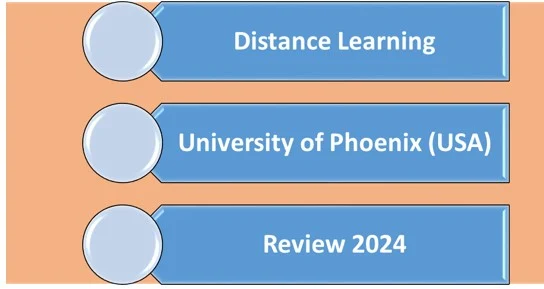Distance Learning Dominates Education Landscape in 2024
But why is
distance learning such a big deal? Well, imagine this: no more rushing to catch
the school bus, no more sitting in crowded classrooms, and no more struggling
to keep up with the teacher's pace. Instead, students can learn at their own
pace, in their own space, and even in their pajamas if they want! Sounds cool,
right?
Top Distance Learning Degrees
in Education Research ...
But distance
learning isn't just about convenience; it's also about inclusivity. In 2024,
students from all walks of life are jumping on the distance learning bandwagon.
Whether you live in a bustling city or a remote village, whether you're a kid
with a disability or an adult with a full-time job, distance learning opens
doors to education like never before.
And guess
what? Technology is the superhero behind this education revolution. With fancy
gadgets like computers, tablets, and smartphones, along with nifty apps and
websites, learning has never been more fun and accessible. Imagine taking a
virtual field trip to ancient Egypt or conducting a science experiment in your
own virtual lab. That's the magic of technology in distance learning!
But wait,
there's more! Distance learning isn't just about watching boring lectures on a
screen. It's also about connecting with classmates from around the world,
collaborating on projects, and getting personalized help from teachers whenever
you need it. In 2024, the classroom isn't just a place; it's a digital space
where learning knows no bounds.
So, buckle up
and get ready for a wild ride through the world of distance learning in 2024.
It's not just a trend; it's a game-changer that's here to stay. Get ready to
explore, learn, and grow like never before, because in the age of distance
learning, the possibilities are endless!
The Rise of Distance Learning:
Distance
learning, also known as online learning or remote education, has surged in
popularity due to its flexibility, accessibility, and convenience. In 2024,
students of all ages, from primary school to higher education, have embraced
this mode of learning. With the rise of e-learning platforms, virtual
classrooms, and web-based instruction, education has transcended traditional
boundaries, allowing learners to access quality education from anywhere in the
world.
Accessibility and Inclusivity:
One of the
most significant benefits of distance learning is its ability to make education
more accessible and inclusive. In 2024, students from rural areas, those with
disabilities, and individuals balancing work and family commitments have found
a lifeline in online education. With just a computer and internet connection,
learners can participate in virtual lectures, access educational resources, and
engage with classmates and instructors, leveling the playing field and opening
doors to opportunities previously out of reach.
Flexibility and Personalization:
Another key
advantage of distance learning is its flexibility and personalization. In 2024,
students have the freedom to learn at their own pace, according to their
schedule and preferences. Whether they are early birds or night owls, distance
learning accommodates diverse learning styles and rhythms. Moreover, with the
proliferation of online resources, learners can tailor their educational
experience, choosing from a wide range of courses, subjects, and learning
materials that cater to their interests and goals.
Technology as a Game Changer:
Technology has
been the driving force behind the success of distance learning in 2024. With
innovations such as video conferencing, virtual reality, artificial
intelligence, and interactive learning platforms, educators have transformed
traditional classrooms into dynamic digital environments. Instructors can
deliver engaging lectures, facilitate discussions, and provide real-time
feedback, fostering active participation and collaboration among students.
Furthermore, technology has enabled the creation of immersive learning
experiences, where learners can explore virtual simulations, conduct
experiments, and solve problems in interactive virtual labs.
Challenges and Opportunities:
While distance
learning offers numerous benefits, it also poses challenges that need to be
addressed. In 2024, issues such as the digital divide, lack of reliable
internet access, technological barriers, and concerns about the quality of
online education remain significant hurdles. Moreover, the isolation and lack
of face-to-face interaction in virtual settings can impact student engagement
and social development. However, these challenges present opportunities for
innovation and collaboration, as educators, policymakers, and technology
developers work together to bridge the gap and enhance the effectiveness of
distance learning.
The Future of Education in
2024: Online Learning
Of course,
distance learning became the big boss of education. It's like learning without
walls, where you can study from anywhere with just a computer and internet.
This change isn't just about convenience; it's about making education available
to everyone, no matter where they are or what challenges they face.
Technology is
the hero here, with cool gadgets and apps making learning fun and easy. Imagine
going on virtual trips or doing experiments in a digital lab – that's the magic
of technology in distance learning!
But it's not
just about tech; it's also about connecting with classmates and getting help
from teachers whenever you need it. In 2024, the classroom isn't a place; it's
a digital space where learning happens without limits.
In the era of
distance learning, get ready to explore, learn, and grow like never before.
It's not just a trend; it's a revolution that's changing the way we learn for
the better.
Distance Learning Guidelines the Way: Important Base
Points for 2024
Virtual Classrooms Everywhere: Most students attend classes online, from the
comfort of their homes or anywhere with internet access.
Flexible Learning Hours: Students have the freedom to choose when they
study, fitting education around their schedules.
Accessible Education: Distance learning breaks down barriers,
allowing people from all backgrounds to access quality education.
Global Reach: Students
connect with peers and educators from around the world, broadening their
perspectives.
Interactive Tools: Engaging platforms offer interactive lessons,
quizzes, and activities to keep learning fun.
Adaptable Teaching: Educators use technology to tailor lessons to
students’ individual needs and learning styles.
Supportive Communities: Online forums and discussion groups foster collaboration
and support among students.
24/7 Resources: Students have access to learning materials and
resources anytime, anywhere.
Tech Integration: Teachers seamlessly integrate technology into
lessons, preparing students for a digital world.
Career Advancement: Distance learning enables professionals to
upskill and advance their careers without pausing work.
Parental Involvement: Parents are more involved in their children’s
education, monitoring progress and providing support.
Cost-Effective: Distance learning often reduces costs
associated with traditional education, such as commuting and accommodation.
Environmental Impact: Online learning reduces the carbon footprint
associated with commuting to physical campuses.
Inclusive Learning: Specialized programs cater to students with
disabilities, ensuring equal access to education.
Real-World Applications: Virtual labs and simulations provide hands-on
learning experiences in various subjects.
Digital Literacy: Students develop essential digital skills,
including online research, communication, and data analysis.
Personal Growth: Distance learning encourages self-discipline,
time management, and independence.
Flexible Assessments: Assessments may include a mix of quizzes,
essays, presentations, and projects to accommodate diverse learning styles.
Cultural Exchange: Students learn about different cultures and
perspectives through global collaboration.
Teacher Training: Educators receive training in online teaching
methods and technology integration.
Data-Driven Insights: Educators use data analytics to track student
progress and adapt teaching strategies accordingly.
Continuous Improvement: Institutions gather feedback from students and
educators to continuously improve online learning experiences.
Hybrid Models: Some institutions adopt hybrid models, blending
online and in-person learning for a balanced approach.
Community Engagement: Online platforms facilitate community engagement
through virtual events, clubs, and extracurricular activities.
Graduation Celebrations: Virtual graduation ceremonies honor students’
achievements and successes.
Professional Networking: Online platforms connect students with industry
professionals for mentorship and networking opportunities.
Research Opportunities: Virtual libraries and databases provide access to a
wealth of research materials for students and scholars.
Language Learning: Online language courses offer immersive experiences
with native speakers and interactive lessons.
Continuing Education: Lifelong learners pursue personal interests and
passions through online courses and workshops.
Resilience and Adaptability: Distance learning equips students with the
resilience and adaptability needed to thrive in a rapidly changing world.
Online Education Market in the
UK [Deep Analysis] [2024]
Sum up in 2024, distance learning has become the
main way people learn. Here are the important things to know:
- You can
study from home or anywhere with internet.
- Learning
hours are flexible, so you can pick times that work for you.
- Everyone can
access education, no matter where they are or their background.
- You can
connect with people from all over the world and learn from different cultures.
- Lessons are
fun and interactive with quizzes and activities.
- Teachers use
technology to help each student learn in their own way.
- There are
online communities where you can get support from other students.
- You can
study anytime, day or night, with online resources.
- Learning
online teaches you important skills for using technology.
- It's cheaper
than traditional education because you don't have to travel or pay for
accommodation.
- Distance
learning helps the environment by reducing pollution from commuting.
- People with
disabilities have equal access to education through special programs.
- You can do
experiments and learn hands-on using virtual labs.
- You learn
how to use the internet for research and communication.
- Distance
learning teaches you to manage your time and work independently.
- Assessments
include different kinds of tests to suit everyone's learning style.
- You can meet
and work with people from different countries.
- Teachers get
training to teach online and use technology.
- Schools use
data to see how well students are doing and improve teaching.
- Some schools
mix online and in-person learning.
- There are
virtual events and clubs for students to join.
- Graduation
ceremonies happen online to celebrate students' success.
- You can meet
professionals online for advice and job opportunities.
- There are
lots of resources for research and learning new things.
- Online
language courses help you learn new languages.
- Lifelong
learners can keep studying things they're interested in.
- Learning
online teaches you to be strong and adapt to changes.
The Most Surprising Education
Technology Industry ...
Just Jest at a Glance:
OK AVERAGELY, In
2024, distance learning has revolutionized education, offering a plethora of
benefits. Students can now conveniently study from the comfort of their homes
or anywhere with internet access, enjoying flexible learning hours tailored to
their schedules. This accessibility ensures that education is within reach for
everyone, irrespective of their location or background. Through online
platforms, learners can connect with peers worldwide, fostering cultural
exchange and diverse perspectives. Lessons are engaging and interactive,
featuring quizzes and activities, while teachers leverage technology to cater
to individual learning styles.
Supportive
online communities provide assistance and collaboration opportunities.
Additionally, distance learning cultivates essential technology skills and
promotes environmental sustainability by reducing commuting. Special programs
ensure inclusivity for people with disabilities, enabling hands-on learning
through virtual labs. Learners develop internet research and communication skills,
alongside time management and independence. Assessments are varied to
accommodate diverse learning preferences, while international collaboration and
networking opportunities abound. Continuous teacher training and data-driven
approaches enhance teaching quality, with some institutions adopting hybrid
learning models.
Virtual
events, clubs, and online graduation ceremonies enrich student experiences,
while professional networking facilitates career advancement. Abundant
resources support research and lifelong learning, including language courses
for diverse linguistic pursuits. Overall, distance learning fosters resilience
and adaptability, preparing learners for the challenges of a rapidly evolving
world.
Today's Distance Learning Courses







